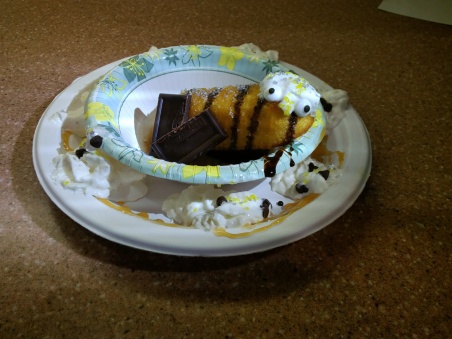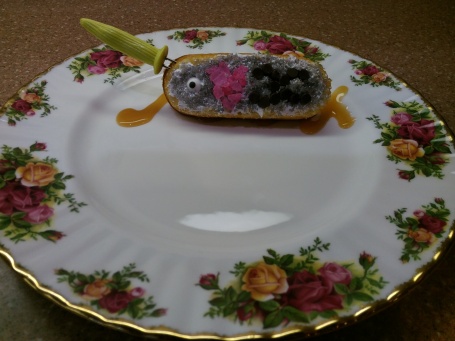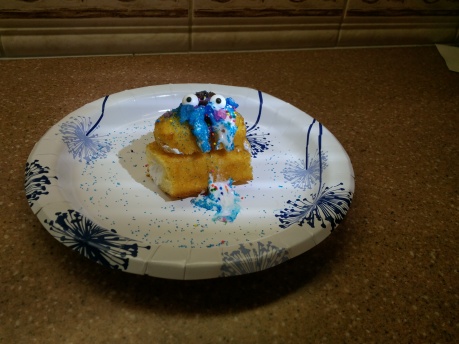Tags
I recently concluded that we’ve taken the completely wrong approach to our financial life. That was nine hours ago. We’re now gourmet pastry chefs.
Research has been conducted. Techniques have been practiced. Orders have been placed. We’ve decided to enter at the lower-end of the gourmet market and work our way up as fame, recognition, and awards make their way to our new bakery. We’re still toying with the name, but I’m thinking there are worse choices than The Tempest in a Teardrop Tart Temple. Our treats will start in the $100-$150 dollar range.
The key to success in the gourmet pastry market is to specialize. We’re Americans. We picked doughnuts.
Doughnuts are made from four main ingredients: milk, flour, sugar, and eggs. You won’t find us buying these in bulk from Costco. We won’t compromise our newly-discovered epicurean standards.
Our milk will be sourced from Arapawa goats, which are an endangered species native to Arapawa Island off the coast of New Zealand. They produce a rich, foamy milk which is entirely dependent on what they eat. Fortunately, our neighbor has a small herd which he’s been using to clear trash from local highways. We have a yard filled with dandelions. Fresh Arapawa Goat Dandelion Milk? That sounds perfect for our marketing department.
Flour is tricky. It’s available cheaply throughout much of the world thanks to Monsanto and Roundup Weed Killer. Of course, Monsanto and Roundup render it unsuitable for our gourmet needs. Fortunately, the Garifuna tribe of Guatemala grow their own wheat and even mill it into flour using flattened granite rocks (from centuries of use) and human skulls. Since missionaries introduced Western culture to the tribe in the 1930’s, new skull grinders have not been made. The last one traces to 1933. They are now being replaced with river-smoothed Arkansas stones. That’s where we’ll be sourcing our flour from.
This little circle of crony capitalism is all courtesy of NAFTA. Thank you, Neocons.
We’re not going to use sugar in our delicious pastry loops. Instead, we’re going to import the sap from young Kapok trees in the Amazonian rain forest. These endangered trees are known for their cotton-like fruit. They can live up to 300 years, as long as they remain in the right neighborhood. That neighborhood excludes land developers, who relentlessly hunt them down just for spite. In fact, by reading this post you’ve saved a Kapok tree. I bet you didn’t think you could do that just by reading an article on the internet, did you? Our apologies if you are a land developer.
Once boiled down, the sap makes a marvelous sweet syrup, which is neither too cloying nor too flat. Importation is a bit problematic at this time, but with our loose border policies and smugglers looking to expand their markets, there are ways. Frankly, TPP would greatly simplify the process.
Our eggs come from the rare Ayam Cerami breed of chicken. These chickens are an iridescent black from crown to tail. They are the only breed whose all-black eggs are laid by the roosters. They are the most progressive member of the animal kingdom.
Of course, all of these fancy ingredients might as well be from Safeway if they aren’t mixed and cooked properly. Our pastry oven comes from the Tuscan region of Italy. It features a Statuario marble cooking surface hand-crafted in Carrara. The fuel chamber is designed to burn Pecan wood, and a series of filters eradicates the scent but leaves 99% of the pretentiousness to soak into the dough.
Glyph has agreed to learn the mysterious dark arts of the Pâtissier. The technique is believed to have originated in the court of Kublai Khan. Marco Polo had to settle for the pasta recipe. It is only thanks to the internet and the desperation of the Tibetan people that a select few in the west even know of the technique.
The secret involves a paper-thin doughy sheet cooked at a precise temperature for a measured few seconds, folded over, and shaped ever-thinner with a tiny pastry hammer. Skillful bakers repeat this process seventy-eight times to create a delicious flaky katana-like masterpiece. It will take Glyph eighteen years to master the process, which is two less than the average baker because Glyph is smart. In the meantime, if any unemployed Oompa Loompas are reading this, we’re hiring.
Of course, the secret to an expensive doughnut lies in creatively plating it. Let’s face it, our target market is much more concerned with their style. They’d pay $100 for a Twinkie if it was presented well. We decided to test some ideas, so invited friends over for a little contest. Many calories were harmed in the creation of these pictures.

That moment when you explain to Codex how these are all needed for “research” for tomorrow’s post…

Glyph’s creation. In an air-conditioned gourmet restaurant on proper bone-china, this would sell for upwards of $40. Not bad for a first attempt.

A family friend understands the target market. Though not perfect, this little guy spells out ‘I Heart Chanel’.

A fine idea nearly ruined by the summer kitchen heat. So we re-branded it as Cthuloid. Soul-suckingly delicious!

My own winning entry. Clearly I’m great at everything 🙂

This masterful angle is gratuitous pastry centerfold material. As the official blog photographer, Glyph did a great job here.
If you’ve made it this far, you might reasonably conclude that we’ve gone mad. You might be right. This is, however, my most charitable attempt at explaining why this actual, real, doughnut sells for almost $2000.

John Phillips via Getty Images
Sadly, I suspect rare ingredients from endangered species prepared by a mysterious cult of Master Pâtissiers is not the reason.
___
The Spork Speaks — Tempest in a Teardrop — tempestinateardrop.com

I thought twinkies were no more, just how old is that box?
LikeLike
Tell him about the Twinkie
LikeLiked by 1 person
The Twinkie plantation was bought by a private investment firm. They are now smaller and less tasty than they used to be. Cost savings, I assume. Those trees require lots of maple syrup fertilizer and twice-daily oompa loompa singing. The new owners cut the singing back to once a day.
The terrible consequences are yet to be seen. Twinkies no longer last forever. Have fun during the next apocalypse 🙂
LikeLiked by 1 person
I didn’t know that.
Thanks, I will.
LikeLike
I think ymay be onto something with personalized Twinkies. Maybe not a $40 something…but something!
LikeLike
You can charge more as long as the name/branding is pretentious enough. That’s why we aren’t skimping on marketing. We’re spending so much on marketing, in fact, that a $40 personalized Twinkie is our break-even price. If we raise it to $80 we can do even more and betterer marketing!
Eventually, a $2000 Twinkie will be achieved!
LikeLike
I wouldn’t pay $2000 for a doughnut, or even a doughnut recipe! Especially since I’m now (mostly) low-carb. Steak and mushrooms cooked in butter! (Still not paying $2k)
LikeLike
The carb meter rolls back over to zero after it gets to 9,999. Don’t ask how we know this…
LikeLiked by 1 person
You want to eat Mushrooms??? RUN CODEX! RUN!!!
LikeLiked by 2 people
Maybe all those “natural” allium-infused butter full-body skin treatments were a mistake…
LikeLike
My wife used to raise Ayam Cemani. They’re magic chickens.
LikeLike
They looked quite interesting when I was doing research for this post. I can only imagine they look even better in person, iridescence usually doesn’t photograph that well.
LikeLike